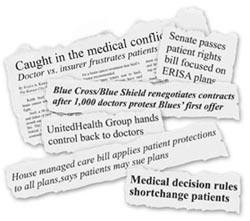
This Week’s Topic:
How To Incorporate Headlines Into Your
Business Advertising! (Part 1 of 2)
Attention-Grabbing Headlines To Help Boost Your Business Success
The success or failure of any business can sometimes be determined by the power of the words that are used to promote it. A headline is basically an advert for an advert, a commercial for a commercial, so it’s important to realize that it’s one of the most essential areas to focus on in the field of copywriting.
The headline is really the most significant element of any sales letter or publicly visible marketing strategy, and for a fairly simplistic reason. It’s the initial part of your business that’s seen by your prospect, the first thing they lay eyes on when they glance at your advert. It grabs their attention and draws them to you. An advert for an advert, pulling your prospect in your direction, causing them to want to learn more about you. It must be so alluring and attractive that the reader is mesmerized and feels compelled to find out more.
Experienced copywriters can’t sing it’s praises enough! Let’s take a brief look at some of this proven knowledge.
Expert’s Quotes:
“On the average, five times as many people read the headline as read the body copy. When you write your headline, you spend eighty cents out of your dollar.”
-David Ogilvy
“Spend hours and hours writing headlines, or even days if necessary. Come up with a good headline, and you are almost sure to have a good ad. Truly the greatest writer can’t save an ad with a poor headline.”
– John Caples
It can sometimes be the equivalent of corporate suicide if an advert doesn’t have a headline of it’s own. They all need to if they intend on being a success.
It’s time to examine some of the key rules that should be followed when creating headlines, the variation and different styles of headlines, consistently effective words to use, and how your skills can be raised to expert level to truly become a master at writing headlines.
Rules of engagement
1) The headline should appeal to the intrinsic interest of the prospect and engage them with those things which are of immediate, or even fleeting, interest to them. Explain the most powerful attributes to your prospect and convey the benefits that they are likely receive. Everybody is interested in how their lives can be improved by the things they invest in, and one of the first questions we subliminally ask ourselves is “What do I get out of this?” The headline you create must strive to answer this question and inspire your prospect to discover more.
2) Failing to attract the right people is the forerunner of failed advertising. The headline must appeal to the prospect in such a way that they are compelled to have a closer look and dig deeper. Capture the imagination of the right prospects, create a bridge between you and their desires.
3) The headline’s goal is to deliver a precise and clear overview of what you offer, in the form of an instantly comprehensible message. Many people only read the headlines so for this reason your headline must endeavour to make an expansive statement, explaining the benefits clearly and driving the prospect to investigate the body copy and find out more.
4) With news of a new product or service incorporated into your headline, it can have an even greater impact and raises the level of curiosity within the reader.
5) Trying to be clever or humorous with headlines can often backfire and end up being ineffective. The reason for this is that humor is a subjective thing and doesn’t always appeal to different people, universally.
6) Use specific words and phrases in your headlines to give the reader a clear understanding. For example “Make $7,972 in 27 Days” is a better headline than “Make Money Now”. Bring specific is a more convincing approach.
7) Try and use the words “easy” and “quick” if they fit the style of product or service you are trying to promote.
8) By utilising both upper and lower case letters and incorporating them in to your headlines it makes them easier to read than if they were written entirely in capital letters. It’s useful and effective to put quotation marks around headlines and a number of independent studies have revealed the the use of quotes around headlines has the effect of increasing readership.
9) Compare and contrast headlines. Put two separate headlines next to each other and see which one works better, is more effective and more attractive.
10) Coming up with the right headline involves an element of trial and error. You need to write many headlines, and closely examine which one is the best to use. Commonly, marketers will spend a number of days writing hundreds of headlines, searching for one that stands out above them all. At a bare minimum, a good number to aim for is 50 headlines to begin with. That will often be just the beginning, and you may need to right another 50 or 100 until you find the right one.
Headlines Nurture Success
Your advert’s success is dependent upon the headline, with a poor headline the whole ad falls apart. Failing to tell your prospect what they get out of it means you won’t attract their attention and they will not want to find out more about you. They won’t even read your advert if the headline doesn’t grab them and as a result you throw away your time, money and diminish your own probability of success.
The second and final part of this series will be published soon, and in the following article we will examine the different styles of headlines and how to select the right type of headline for your advert to maximize it’s chances of drawing the reader to you.
